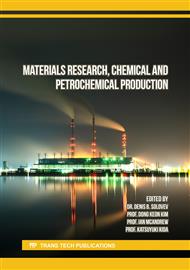[2]
N.S. Belinskaya, E.D. Ivanchina, I.M. Dolganov, N.Ye. Belozertseva, Computer modeling system of the process of catalytic dewaxing of diesel fuels, Polzunovskiy Vestnik. 3 (2019) 99-106.
DOI: 10.1002/ceat.201900516
Google Scholar
[4]
N.S. Belinskaya, E.V. Frantsina, E.D. Ivanchina, Unsteady-state mathematical model of diesel fuels catalytic dewaxing process, Catalysis Today. Vol. 329 (2019) 214-220.
DOI: 10.1016/j.cattod.2018.10.041
Google Scholar
[5]
E.V. Frantsina, N.S. Belinskaya, N. Popova, E.V. Frantsina, Development of the Mathematical Model of Diesel Fuel Catalytic Dewaxing Process Taking into Account Factors of Nonstationarity, MATEC Web of Conferences, Vol. 85, Chemistry and Chemical Technology in XXI Century, CCT 2016, 01023, p.5.
DOI: 10.1051/matecconf/20168501023
Google Scholar
[6]
N.I. Krivtsova, et. al., Influence of technological parameters and hydrogen-containing gas consumption on the efficiency of middle distillates hydrodesulfurization process, Petroleum Science and Technology. Vol. 37, 2 (2018) 181-189.
DOI: 10.1080/10916466.2018.1533857
Google Scholar
[7]
E.V. Frantsina, et. al., Thermodynamic analysis of the reactions of sulfur containing compounds in the process of diesel fractions hydrodesulfurization on the base of quantum-chemical calculations. Petroleum and Coal. Vol. 61, iss. 1 (2019) 74-80.
Google Scholar
[8]
E.V. Frantsina, A.A. Grinko, N.I. Krivtsova, et. al., Identification of hydrocarbon characteristics of diesel fractions and assessment of their effect on fuel operational, Petroleum Science and Technology. Vol. 38, 4 (2020) 338-344.
DOI: 10.1080/10916466.2019.1705856
Google Scholar
[9]
E.D. Ivanchina, E.N. Ivashkina, V.A. Chuzlov, et. al., Formation of the component composition of blended hydrocarbon fuels as the problem of the multi-objective optimization, Chemical Engineering Journal, Vol. 383121283 (2020) 9.
DOI: 10.1016/j.cej.2019.03.159
Google Scholar
[10]
M.V. Kirgina, I. Bogdanov, N.S. Belinskaya, et. al., Expansion of the feedstock base for the production of diesel fuel by involving the heavy fractions and cold flow improvers, Oil & Gas Science and Technology. Vol. 75, 31 (2020) p.8.
DOI: 10.2516/ogst/2020026
Google Scholar
[11]
N.S. Belinskaya, E.N. Mauzhigunova, D.A. Afanaseva, E.K. Vymyatnin, Identification of regularities of vacuum gas oil hydrocracking process, Petroleum and Coal, Vol. 62(2) (2020) 390-395.
Google Scholar
[13]
E.D. Ivanchina, I.M. Dolganov, V.A. Chuzlov, N.S. Belinskaya, Intensification of flow blending technology in the production of motor fuels by the method of mathematical modeling, Chemical Engineering & Processing: Process Intensification. Vol. 122 (2017) 415-424.
DOI: 10.1016/j.cep.2017.07.015
Google Scholar
[14]
M.V. Kirgina, I. Bogdanov, A.A. Altynov, N.S. Belinskaya, Calculation method for prediction of the cetane index of blended diesel fuels, Petroleum and Coal. Vol. 61, iss 1 (2019) 110-119.
Google Scholar
[15]
N.S. Belinskaya, et. al.,Estimation of technological parameters influence on the cold flow properties and yield of diesel fuel in the process of catalytic dewaxing, Petroleum and Coal. Vol. 60, iss. 1 (2018) 7-13.
Google Scholar
[17]
G.Yu. Nazarova, E.N. Ivashkina, E.D. Ivanchina, et. al.: Modeling of the catalytic cracking: Catalyst deactivation by coke and heavy metals, Fuel Processing Technology, Vol. 200, 106318 (2020) p.12.
DOI: 10.1016/j.fuproc.2019.106318
Google Scholar
[18]
N.S. Belinskaya, E.D. Ivanchina, I.M. Dolganov, N.E. Belozertseva, D.A. Afanaseva, Computer Modeling System of the Industrial Diesel Fuel Catalytic Dewaxing Process Chemical Engineering and Technology. Vol 44(1) (2021) 31-37.
DOI: 10.1002/ceat.201900516
Google Scholar
[19]
N.S. Belinskaya, E.N. Mauzhigunova, D.A. Afanasyeva, V.V. Bykova, A.S. Lutsenko, Studying the Regularities of Atmospheric Oil Distillates Catalytic Dewaxing Process Using the Method of Mathematical Modeling Petroleum and Coal. Vol 62(3) (2021) 951-956.
Google Scholar
[20]
E.D. Ivanchina, E.N. Ivashkina, I.O. Dolganova, N.S. Belinskaya, Mathematical modeling of multicomponent catalytic processes of petroleum refining and petrochemistry, Reviews in Chemical Engineering. Vol 37(1) (2021) 163–191.
DOI: 10.1515/revce-2018-0038
Google Scholar


